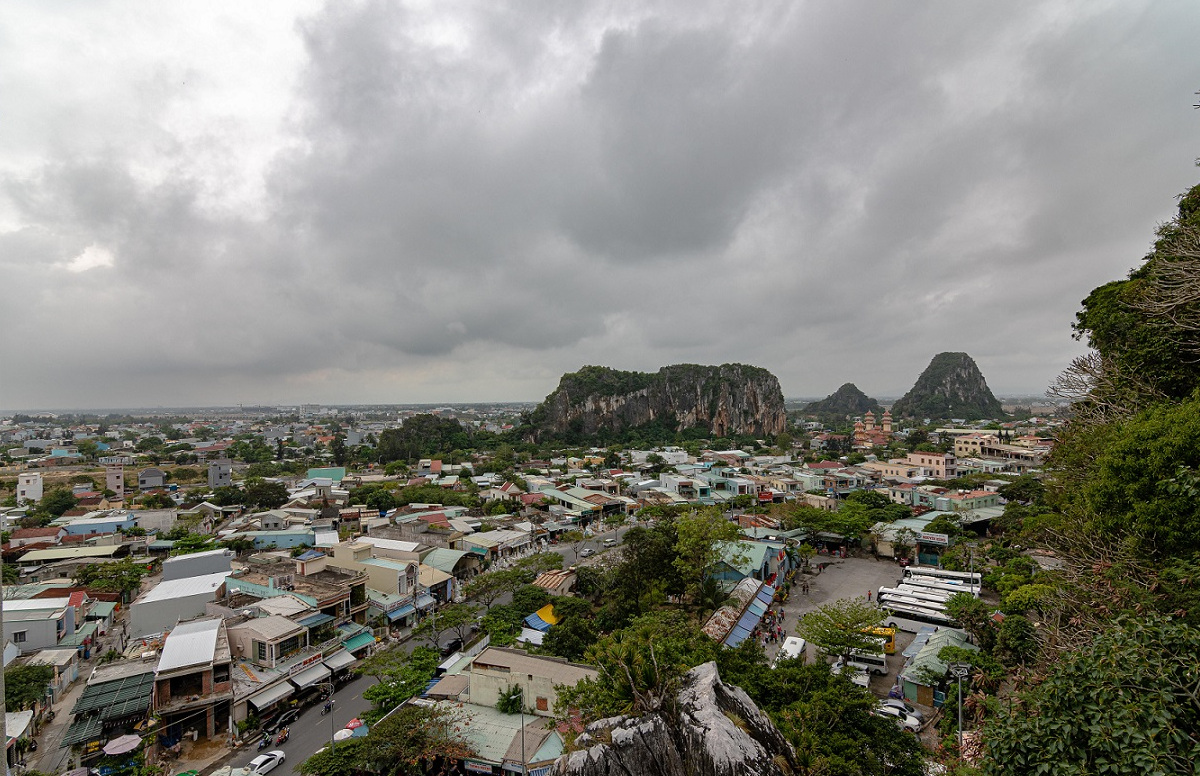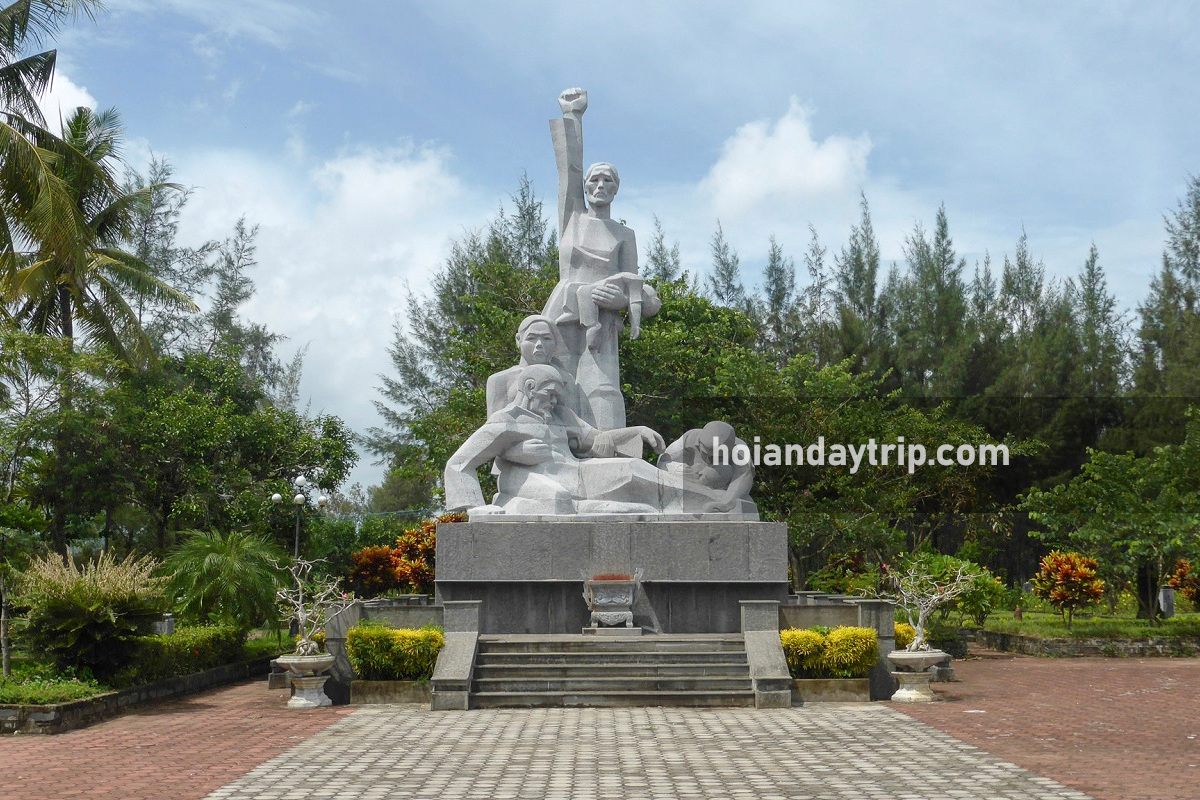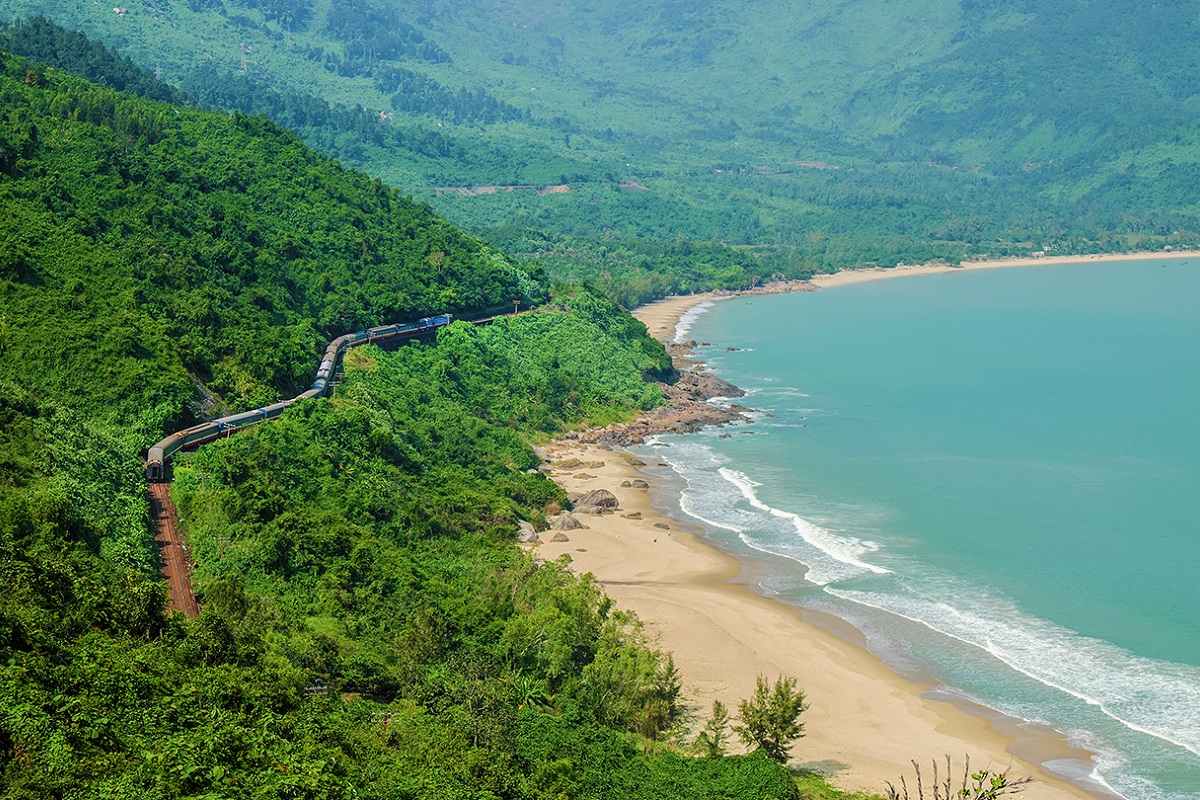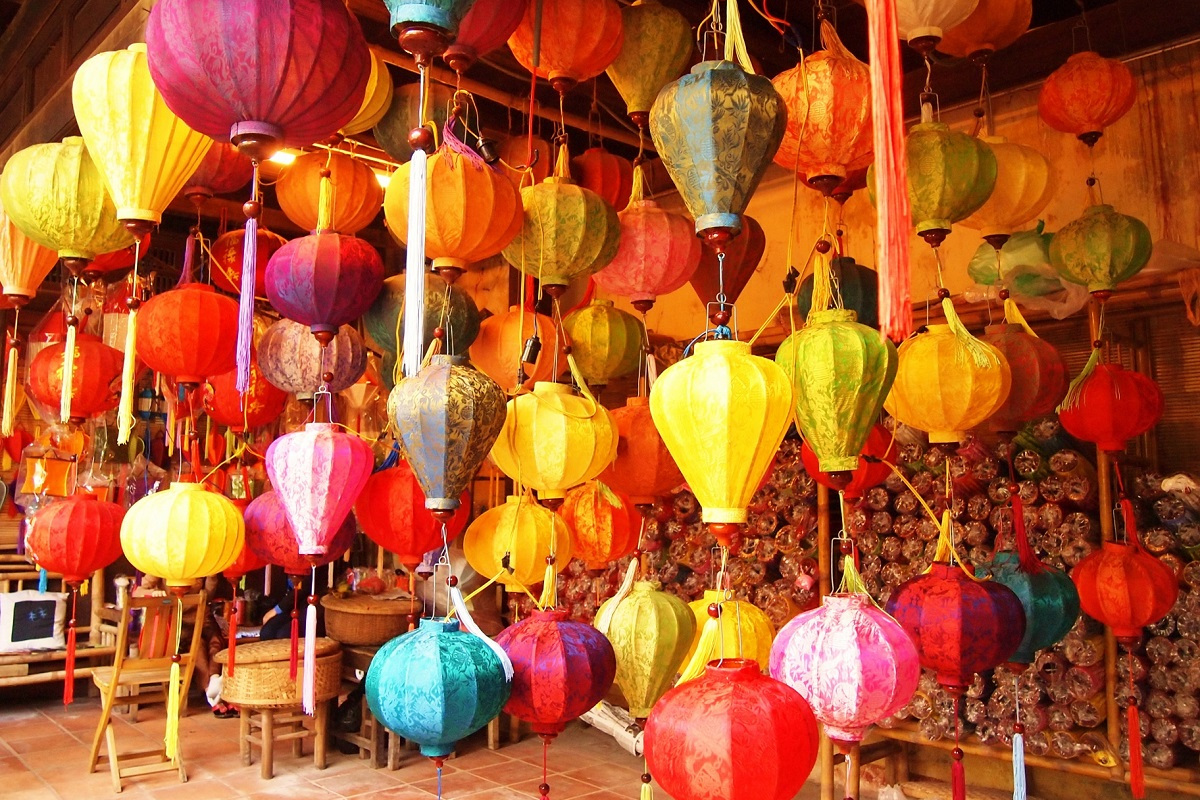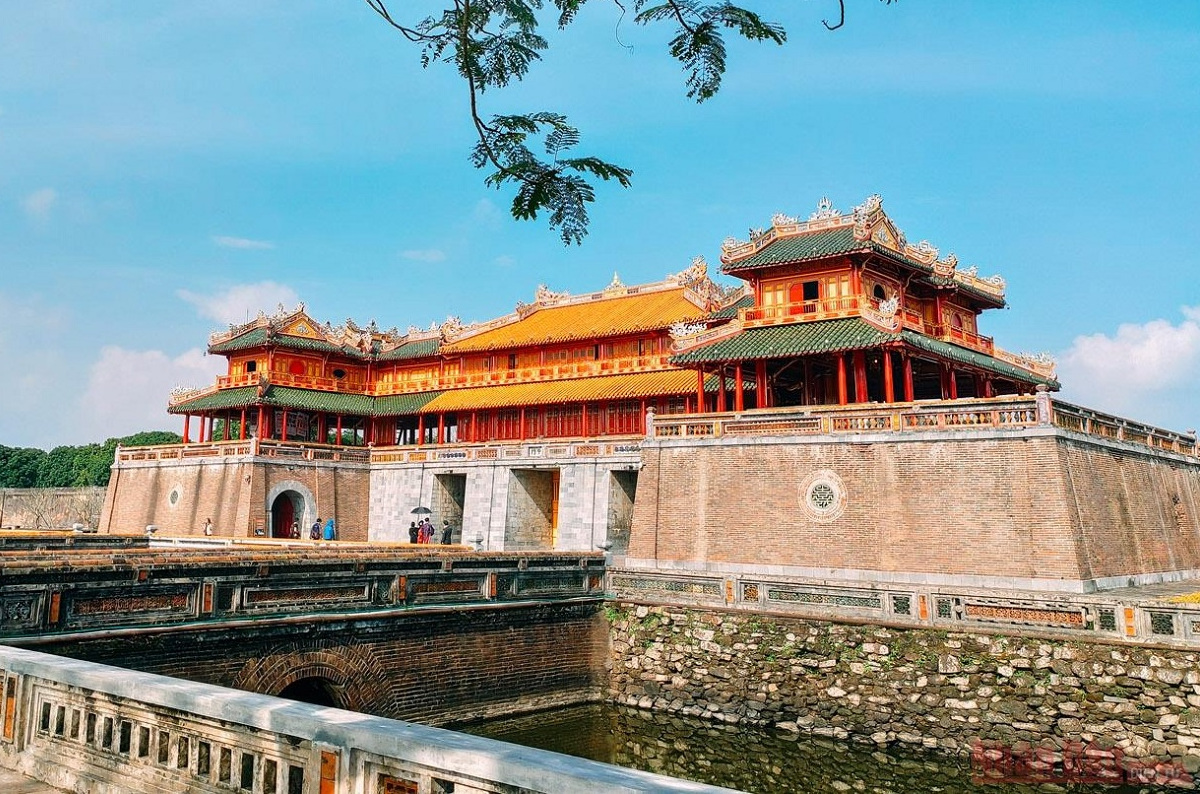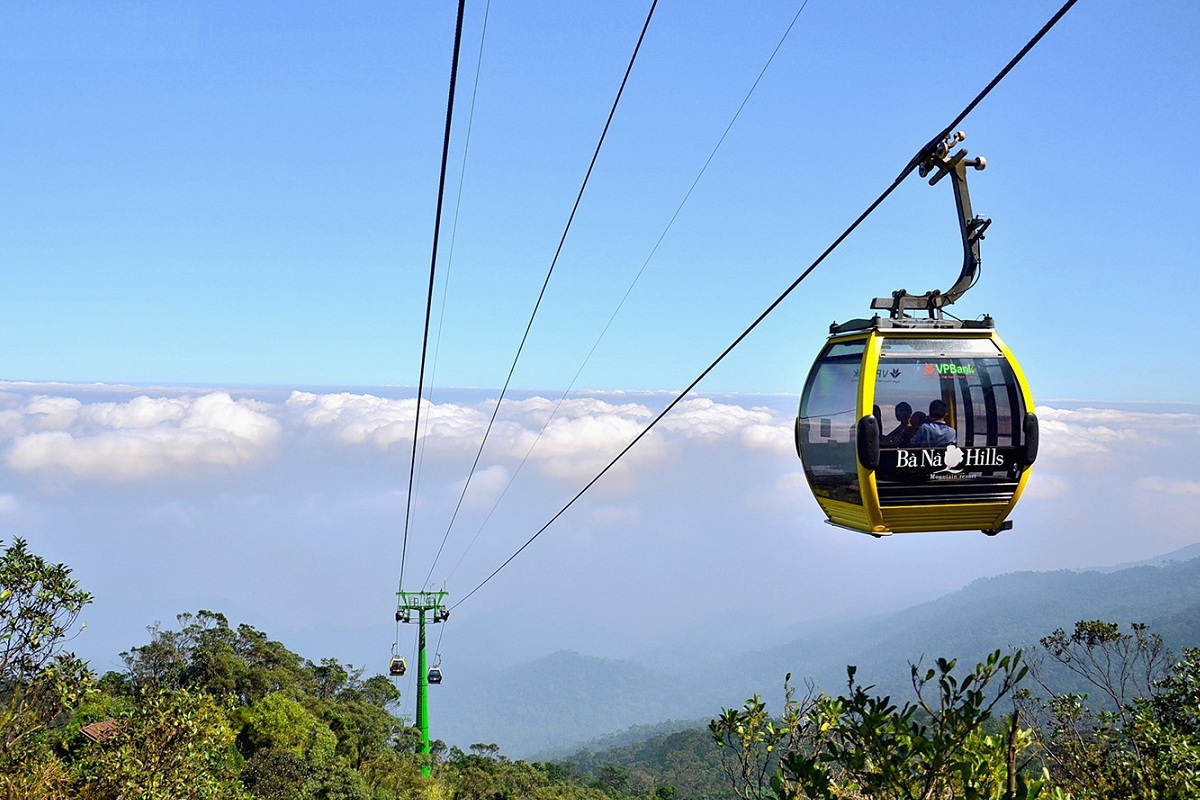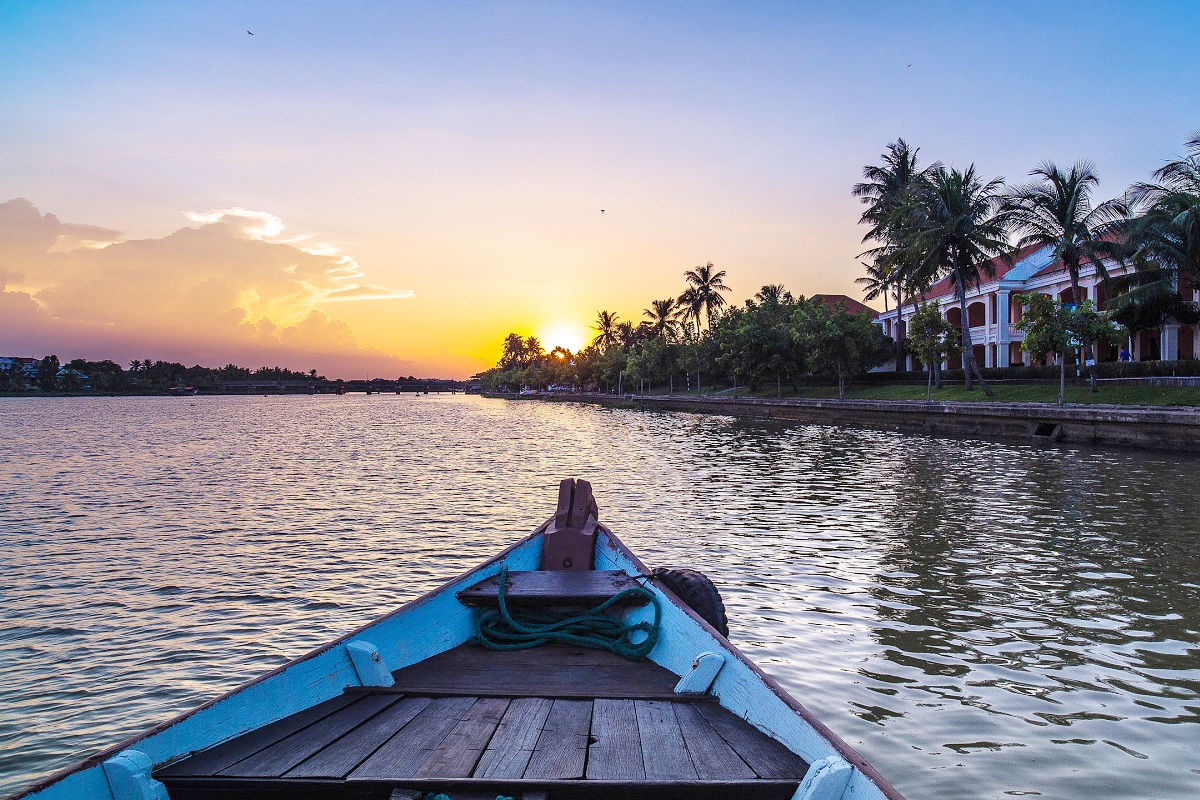Truong Son or Annamite Range is the most dramatic mountain ridge in Vietnam. When it juts out into the sea, spectacular Hai Van Pass is formed. This amazing sculpture of nature is a high wall where two sides of it have different features. While on the north side, the temperature is low in the winter, it’s much warmer in the south one. The cold monsoon winds are so hard to “climb” the mountains. For geographers, the pass is the border between Northern and Southern climates. For locals, it’s the border between Da Nang and Hue. Instead of crossing by road only formerly, today there are two other choices for passengers, by train and tunnel.
For travelers staying in Central Vietnam, a ride to the Hai Van Pass is one of their favourites. The best is with a motorbike, because of much more adventuring vibes than other vehicles. A ride may be a half-day experience from Da Nang or Hoi An, or a full-day transfer to Hue from those cities. Here, everything the visitors need to know about Hai Van Pass is outlined, in detail. We recommend reading the guide to Hoi An and Da Nang to Hue by train also, because the journey is among the biggest attractions of international tourists.
See also:
- How to Get from Hoi An to Hue (and vice versa)
- How to Get from Da Nang to Hue (and vice versa)
- Lang Co Beach – A Full Guide
- Travel Guide to Hue Imperial City

Table of content
- 1 About Hai Van Pass in Vietnam
- 2 Hai Van Pass Weather
- 3 History of Hai Van Pass
- 4 Things to See in Hai Van Pass
- 5 Experiences in Hai Van Pass
- 6 How to Get to Hai Van Pass
- 7 Self-Riding the Hai Van Pass by Motorbike
- 8 Hai Van Pass Tour
- 9 Hai Van Pass Facts
- 10 Travel Guide to Lang Co Beach
- 11 Hai Van Pass on Google Maps
- 12 Related Posts
- 13 Non Nuoc Beach: The Famous Beach of Da Nang
- 14 How to Get from Da Nang to My Son Sanctuary
- 15 Bach Ma National Park: Hiking, Trekking in Da Nang and Hoi An
- 16 Am Phu Cave (Hell Cave) – Things to Do in Da Nang
- 17 Asia Park and Sun Wheel in Da Nang (Sun World Da Nang Wonders)
- 18 How to Get to Golden Bridge from Da Nang
- 19 Da Nang Food Specialties: What to Eat in Da Nang
- 20 How to Visit Golden Bridge Vietnam
- 21 Da Nang Shore Excursions: Guided Tours From Tien Sa Port
- 22 Han Market (Cho Han): Where to Shop in Da Nang?
- 23 Da Nang Cathedral (Da Nang Pink Church)
- 24 Things to Do in Ba Na Hills Besides Golden Bridge
- 25 Da Nang Half Day Tours
- 26 Da Nang Private Car and Driver
- 27 Da Nang and Hoi An Itinerary for Visitors Staying Overnight in Hoi An
- 28 Da Nang Things to Do: Guide to What to Do in Da Nang Vietnam
- 29 Da Nang Best Things to Do and Reasons
- 30 How to Get From Hoi An to Da Nang
- 31 Hoi An or Da Nang: Which is Better for First Time Visitor?
- 32 My Son Sanctuary Tour
- 33 Da Nang Best Area to Stay: Guide to Where to Stay in Da Nang
- 34 Da Nang Cave Tour: Best Underground Activities in Da Nang
- 35 Da Nang Best Time to Visit: Guide to Best Weather in Da Nang
- 36 Da Nang Weather by Month: Guide to Monthly Weather in Da Nang
- 37 What to Do in Da Nang At Night
- 38 Lang Co Vietnam Travel Guide
- 39 What to Do in Da Nang for 3 Days
- 40 My Khe Beach: A Complete Guide to Da Nang’s Best Beach
- 41 Da Nang Day Trips: Guide to Best Day Tours From Da Nang
- 42 Museums in Da Nang
- 43 Linh Ung Pagoda: Trio of Da Nang’s Holiest Mountain Temples
- 44 Da Nang Night Market: A Thing To Do in Da Nang at Night
- 45 Guide to Son Tra Mountain (Monkey Mountain) in Da Nang, Vietnam
- 46 Ba Na Hills Tour
- 47 Da Nang Cable Car
- 48 How to Get from Da Nang Airport to Hoi An
- 49 Da Nang to Hoi An: Best Da Nang Airport Transfer and More
- 50 Hai Van Pass Da Nang: Map, Route, Weather, History, Tour
- 51 Da Nang Attractions Guide: What to See in Da Nang Vietnam?
- 52 Guide to Lady Buddha (Goddess of Mercy) in Monkey Mountain, Da Nang
- 53 My Son Sanctuary Travel Guide
- 54 Da Nang Museum of Cham Sculpture
- 55 Dragon Bridge Da Nang: The Fire-Breathing Da Nang Bridge
- 56 Ba Na Hills Travel Guide: A First Timer’s Complete Guide
- 57 Golden Bridge Da Nang: A Guide to The Iconic Da Nang Bridge
- 58 Da Nang Bridge: A Guide to Famous Bridges in Da Nang
- 59 Ba Na Hills Cable Car: World Record, Cost, Reschedule, Map
- 60 Da Nang Mountain Temple: Marble Mountain’s Pagodas, More
- 61 Da Nang Caves: Underground World of the Marble Mountains
- 62 The Marble Mountains: Guide to Da Nang’s Iconic Mountain
- 63 Featured Tours and Experiences
- 63.0.1 Bach Ma National Park Tour from Hue
- 63.0.2 Bach Ma National Park Tour from Da Nang/Hoi An
- 63.0.3 Hoi An Sunrise Fish Market Tour
- 63.0.4 My Lai Massacre Tour
- 63.0.5 Golden Bridge/Ba Na Hills & Hoi An Tour
- 63.0.6 Hoi An Instagram Tour
- 63.0.7 Ky Anh Tunnel & Tam Thanh Mural Village Tour
- 63.0.8 Da Nang to Hue Motorbike Tour with Hai Van Pass & Easy Rider (1 Way)
- 63.0.9 Hue to Da Nang Motorbike Tour with Hai Van Pass & Easy Ride (1 Way)
- 63.0.10 Hue to Hoi An Motorbike Tour with Hai Van Pass & Easy Rider (1 Way)
- 63.0.11 Hoi An to Hue Motorbike Tour with Hai Van Pass & Easy Rider (1 Way)
- 63.0.12 Tra Que Vegetable Village Tour with Cooking Class
- 63.0.13 Ba Na Hills Half Day Tour from Hoi An
- 63.0.14 Marble Mountain & Hoi An Day Tour from Da Nang Port
- 63.0.15 Hue Day Tour from Chan May Port with Lunch
- 63.0.16 Marble Mountain & Hoi An Tour from Chan May Port
- 63.0.17 Ba Na Hills/Golden Bridge Tour from Da Nang Port
- 63.0.18 Ba Na Hills/Golden Bridge Tour from Chan May Port
- 63.0.19 Golden Bridge Private Tour with Ba Na Hills & Lunch
- 63.0.20 Ba Na Hills Afternoon Tour with Golden Hands Bridge
- 63.0.21 Ba Na Hills Private Tour with Golden Hands Bridge
- 63.0.22 Ba Na Hills Half Day Tour with Golden Bridge
- 63.0.23 Ba Na Hills Early Morning Tour to Beat the Crowds
- 63.0.24 Golden Bridge and Ba Na Hills Night Tour
- 63.0.25 Golden Hands Bridge Tour In Sunrise or Sunset (1/2 Day)
- 63.0.26 Cam Kim Island Bicycle Tour From Hoi An
- 63.0.27 Cham Island Tour From Hoi An (Group Tour)
- 63.0.28 Cham Island Tour From Da Nang (Group Tour)
- 63.0.29 Hoi An Vegetarian Food Tour
- 63.0.30 Hoi An Evening Walking Food Tour with Local Foodie
- 63.0.31 Private Hoi An Basket Boat Tour (Shuttle Bus, Bicycle, Bike)
- 63.0.32 Half-day Am Phu Cave Tour (Private)
- 63.0.33 Hoi An Countryside Tour by Electric Car or Bike
- 63.0.34 Da Nang Tour Package From Singapore
- 63.0.35 Hoi An Evening Tour From Da Nang with Lantern Boat Ride
- 63.0.36 Hoi An Walking Food Tour Through Laneways
- 63.0.37 My Son Sanctuary and Hoi An Old Town Tour
- 63.0.38 My Son Day Trip From Hoi An including Marble Mountains and Basket Boat
- 63.0.39 Half Day Hoi An City Tour With River Cruise
- 63.0.40 Son Tra Peninsula Tour with Marble Mountains (Private/Small Group)
- 63.0.41 Hue Day Trip From Hoi An with Hai Van Pass, River Cruise & Lunch
- 63.0.42 Hoi An Ancient Town and Countryside Tour (Bests of Hoi An Tour)
- 63.0.43 Hoi An Tour From Da Nang Airport (Private, Optional Lunch)
- 63.0.44 Hoi An Day Trip From Da Nang (Marble Mountains, Basket Boat, Old Town)
- 63.0.45 Da Nang City Tour From Airport (Private, Optional Lunch)
- 63.0.46 Hoi An City Tour with Lantern Class, Lantern Boat, Night Market & Local Food Sampling
- 63.0.47 Marble Mountains, Basket Boat Ride & Hoi An Old Town Walking Tour
- 63.0.48 Marble Mountains & Golden Bridge/Ba Na Hills Day Tour
- 63.0.49 Marble Mountains & Monkey Mountain Tour (Half-day, Private)
- 63.0.50 Private Golden Bridge Sunrise Tour (Half-day, Optional Lunch)
About Hai Van Pass in Vietnam
A Quick Introduction
In the middle of the country, Hai Van Pass is a protrusion of the Annamite Range jutting out into the Pacific Ocean. It’s the most spectacular and most famous (or rumoured) mountain passes in trans-Vietnam routes. The road over it is 20 kilometers long, featuring nearly-vertical mountain slopes on one side and deep valleys on the other. This feature provides much scenic outlooks along the ride that one of things to draw tourists. Hairpin bends, hidden temples and ancient ruins are other interests. In many months, its high elevations are soaked in a dense mist caused by the high humidity. To cross the pass, now people can get a train or move through the tunnel. Praised to be the best coastal road in the region, Hai Van Pass is the theme for one episode of Top Gear.
Names of Hai Van Pass
Hai Van means “the ocean and cloud”. It’s named by Le Thanh Tong king in 1470 when he traveled to the south to capture Champa kingdom’s capital. Previously, local people often called this wonder Ai Van (the Cloud pass). In colonial times, French soldiers nicknamed it “the road without joy”.
Hai Van Pass Elevation
Top of the Hai Van Pass Vietnam is around 495 meters above the sea level, correspondingly 1,627 feet. There, the entire Da Nang’s bay and Lang Co peninsula can be observed, giving it a strategic location for the military. Vietnamese, French and American armies in turn construct protective buildings in it. Now, the remains are still visible.
Hai Van Pass Top Gear
First produced in 2002, the Top Gear is a television series and one of the most commercially successful programmes of the BBC. In 2006, the Specials (special edition episode) was launched, and two years later, Vietnam became the inspiration for directors. Fun experiences and wonderful landscapes along 1,600 kilometers around the country are encapsulated in 70 minutes. Hoi An to Hue via Hai Van Pass is the 4th leg, after Nha Trang to Hoi An and before Hue to Hanoi capital.
Top Gear Hai Van Pass Episode
In 2008, Hai Van Pass appeared in the “Top Gear: Vietnam Special ”, a 75-minute episode for the motoring programme Top Gear of the BBC. It’s the final one of 12 in the world-favoured series. In the beginning, three hosts Jeremy Clarkson, James May and Richard Hammond meet up in a marble shop. Then, all ride their own bike along the bayfront of Da Nang. In the passage, the introduction written by Jeremy describes the Hai Van Pass as “a deserted ribbon of perfection” and “one of the best coast roads in the world”. Later scenes show how much the trio enjoys their ride. A stop (in Da Nang slope) and another in Hue’s slope are made for viewing beautiful landscape. At there. the men use the words “fabulous”, “fantastic”, “increbible” to express the beauty. To watch, just type title of this section in Youtube.
The Hai Van Pass Tunnel
Under the collaboration between Vietnamese and Japanese engineers, Hai Van Pass Tunnel 1 was constructed from 2000 to 2005. Providing the quickest passage from Da Nang to the other side, it aims to reduce traffic accidents on the pass. Its length is 6,28 kilometers, making it the longest of its kind in South-east Asia. After over a decade in operation, its sister the Hai Van Tunnel 2 was built in 2017 to the right. According to official regulations, motorcycles, bicycles, trucks carrying animals and petrol are not allowed to ride through. Non-motorized vehicles can be transferred by another vehicle, with a fee if they don’t like to drive up the rugged pass. Available from 6 a.m to 10 p.m, the service helps the riders to keep their safety, especially during the evening and the wet season.


Hai Van Pass Weather
In the dry season, from January to July, the road is dry and the scenic outlooks show their best in Hai Van Pass. The conditions make the period become the finest time to visit (or have a first ride ever). Ancient remains in the top and bird-eye views are also fully seen. One of the most important things to look out for is the temperature. It’s high daily, and reaches the highest degrees in the midday. So, the riders are advised to hit the road in earlier or later hours, to avoid strong heat. In the end of afternoon, sunset down the horizon is really nice to see from any slopes. The hottest months are June and July when the outside temperature may increase to 40oC. Putting sunglasses, sun cream and lots of water in the bag before leaving the room.
From August to December, the rains often occur and by that, the mist hides the summit of Hai Van Pass frequently. From a far distance, visitors can see and decide to ride or don’t ride up there, or wait for a better chance later. Of course, everything is not really clear to sightsee in the highest elevations and the view is blocked. In lower places, sky is cloudy and browny, still allowing visitors to look at pretty scenery. However, those are not great conditions to support clear and cheerful pictures. The most-loved characteristic is cool temperature, nearly perfect for outdoor activities. Check the weather forecast in advance, if planning to come between October and December. Typhoons often happen, followed by dangerous situations in the mountains. A raincoat is the essential personal item which any visitor must have in this season.
History of Hai Van Pass
Ancient Times and Legends
As the most rugged and dangerous trail in ancient times, people composed a sentence that is still used today. Its full meaning is “walkers are terrified of Hai Van Pass and boatmans are terrified of underground waves around its foot”. According to history books, the trekkers may face robbers, tigers and bad weather while walking along the pass. However, there are no other choices, so people must move across when needed.
If lucky enough, the walkers could see a miracle and rare flower (namely hoa ngai). It blooms in the spring and after falling into the sea by the wind, it helps the fish which eat it to become a dragon. In the folk story of Cham people who resided in the land before the Vietnamese, the dragon can turn into a human. One day, it falls in love with Cham’s princess and wants to rob her for itself but fails. The patron god Shiva uses the bow and arrow to kill it previously. In Cham’s language, the dragon is called “Makara” and the statue of this legendary animal has been exhibited in the Da Nang Museum of Cham Sculpture.
Vietnamese Dynasties
Hai Van Pass is owned officially by current Vietnamese from 1306 when the Champa king gave the land as a wedding present. However, there are not many people who come to the new territory to settle down, because it’s remote, near the frontiers. The first Vietnamese king to travel the pass was Le Thanh Tong, in 1471 when he led the army to capture Champa’s capital Vijaya. He aimed to vigorously resolve the Southern border conflicts. While standing on the summit, the beauty of nature amazed this 30-years-old emperor and he titled the whole pass “the most marvelous wonder (of Vietnam). He got the win then.
Another Vietnamese king linked to the history of the Hai Van Pass is Minh Mang. He was 2nd emperor of the Nguyen dynasty, reigning the country from 1820 to 1840. At the peak of prosperity, he put great care into national defense very much. In 1826, Hai Van Gate, an outpost where imperial soldiers always presented, to protect the capital from its southernmost. Cannons, telescopes and flags were equipped, to observe and signal for the strongholds below. Placed in the top of the pass, people there also were responsible for monitoring the traffic in the first trans-Vietnam trail (thien ly). Walkers had to pay a small fee if they liked to go to the other side. See details of what visitors can see today in the below section here.
Hai Van Pass during Vietnam Wars
The French army occupied the Hai Van Pass in 20th century when they established Tourane city (today Da Nang). The soldiers built bunkers around the Hai Van Gate and converted some buildings into a new function. Because of a very strategic point in the eyes of military men, the Vietminh (League for the Independence of Vietnam) led by Ho Chi Minh attacked on this, to gain control. French troops felt so exhausted in fighting against and said that Hai Van is “the road without joy”. During the second Vietnam war, the Americans and South Vietnamese army were based here. Taking advantage of frequent mist, communist guerillas attacked many times. In the evening, they also made the enemy feel stressful and nervous everlastingly. In March 1975, North Vietnam army took control, and now, the place is free from military activities.
Battles in Hai Van Pass
The memorial stele by the main road, at the top of Hai Van Pass, provides information about three battles in French colonial time. The first occurred in February 1947 and after it, the 19th battalion (of Vietnamese) killed 20 French and African soldiers, and 8 military cars. Three months later, another battle happens. the French brigadier Roger, leader of the army in Central Vietnam and 100 soldiers are killed by the gun of the enemy. In addition, the communists also bomb the train in the tunnels and vehicles in lower elevations. 300 solders more loose their live in Vietnam. The third battle starts in January 1949, and like two previous ones, the French suffered the heaviest losses.
Hai Van Pass Deaths and Rumors
Hai Van Pass is thought to be the most dangerous pass in the trans-Vietnam highway. Local people still see many traffic accidents occurring along it, because of many reasons. When cruising, visitors can see temples on a side of the main road, belonging to victims. On the mountain side, there are two large groups of temples, generally called “Tiger temple” where a man dedicates his life to take care of them. He also repairs the broken motorcycles for free.
The Hai Van Underpass Constructions
Construction of the Hai Van Tunnel is one of the turning points in history of the Hai Van Pass. Operated since 2005, the South-east Asia’s longest tunnel has been serving over 10,000 vehicles one day, and around twice in the holidays. Not allowed for access of motorcycles and bicycles, it closes a few hours (in the lowest period) to clean and maintain. In Da Nang’s portal, a temple for worship of the God of Mountain is built and a banyan tree symbolizing the permanence, is planted next to. In 2017, sister Hai Van Tunnel 2 is constructed.
Things to See in Hai Van Pass
Top of Hai Van Pass – Hai Van Gate and Bunkers
At an elevation of nearly 500 meters, “Hai Van Gate” is actually a couple of gates instead of one like how people think. Built in 1826 under request of Minh Mang king, these brick structures are the last remains of a fortress which protected Hue citadel from the southernmost. The nearest gate from the main road is called Da Nang gate because it faces the city of the same name. Above the arch, there are two stone tablets with Chinese words, the first meaning “the most striking wonders (of Vietnam)” and the other indicating the name of the whole complex. Following the unpaved road, visitors can see the second remains, Hue Gate. In the surroundings, the French and American army added bunkers to defense at this strategic military location. Before being designated to be a national site, it’s possible to climb the top of bunkers to take photos.
Hai Van Gates and everything around them have been restored. In the near future, visitors will see fully-complete buildings and cannons just like in the past.
Hai Van Pass Scenic Lookout
Hai Van Pass is famous for many picturesque viewpoints, seen from the roadside, the summit or top of the giant rocks. Definitely, there are nice backgrounds for traveling pictures and social media posts. On the Da Nang (Southern) side, a panoramic scenery is easy to see from the right of the road. It includes light-blue water of the bay, purple Monkey Mountain and the city in the front, and white sandy beaches and luxuriant vegetation in the back. The train moves several times of the day down the coast. Near the summit, motorbike riders often stop to photograph the hairpin bends. Some of the photos they take get the most interactions on Instagram. Hai Van Gate at the highest elevation is no doubt a must to know. While standing there, clouds accompanied with strong winds may fly over you.
Down to the Hue’s side, some other hairpin bends are seen but less popular to tourists. Trees cover the view more but every time the “fence” opens, the scenery is breath-taking. A picture with cape to cape is absolutely possible to capture. Sometimes, the rocky cliffs with white waves in the foot or railway bridges are also shown before the eyes. At the end of the pass, the Lang Co peninsula between two blue bodies of water is the highlight. One of the most iconic photos is taken from the roadside near the estuary, not crossing the railway yet. Tourist buses always recommend stopping there, and if lucky enough, the train is the closest ever. Riding under the very-high bridge, turquoise Lang Co (or Lap An) lagoon is the next destination.
Beaches at Foot of Hai Van Pass
Beaches in the foot of the Hai Van Pass are white sandy, private and visited by local campers every weekend. The longest one is Lang Van, the crescent stretch of sand seen from Da Nang’s slopes. Having been a leper colony for nearly two decades (until 1996), some leprosy patient’s families are staying back there. To get it, visitors need to trek down from the main road by trails and then along the railroad track. If you would like to go camping, this pretty coast is one of the best choices in Da Nang. On the other side, there is another small, hidden beach. It’s called Bai Chuoi (the Banana Beach) where snorkeling opportunities can be obtained. Because of being far from the pass route, a long trek is required.
Lastly, more famous above mentioned, Lang Co Beach is one of the most unspoiled shorelines in the region. It’s straight, stretches over 5 kilometers and free from crowds of tourists. As a part of Lang Co Bay, member of the World’s most beautiful bays club, this impression provides some options of high-end resorts to the north. Near the estuary, there are local-style seafood eateries, sun beds and fisherman boats on the sands. Read our separate article for Lang Co Beach in centralvietnamguide.com/lang-co-beach.
Lang Co Lagoon (aka Lap An Lagoon)
Turquoise and shallow, Lang Co Lagoon is always in the itinerary of visitors who plan to explore the Hai Van Pass. It owns a killer, outstanding beauty. It’s possible to expect mirror-like water dotted with stilt houses and the reflection of green towering mountains capped by white clouds. Locals raise oysters for living there, for making the sauce, supplying restaurants and hotels. Seafood restaurants and coffee shops are established on a side of the lagoon edge, Nguyen Van Rd. See more details in our guide via centralvietnamguide.com/lang-co-lagoon.

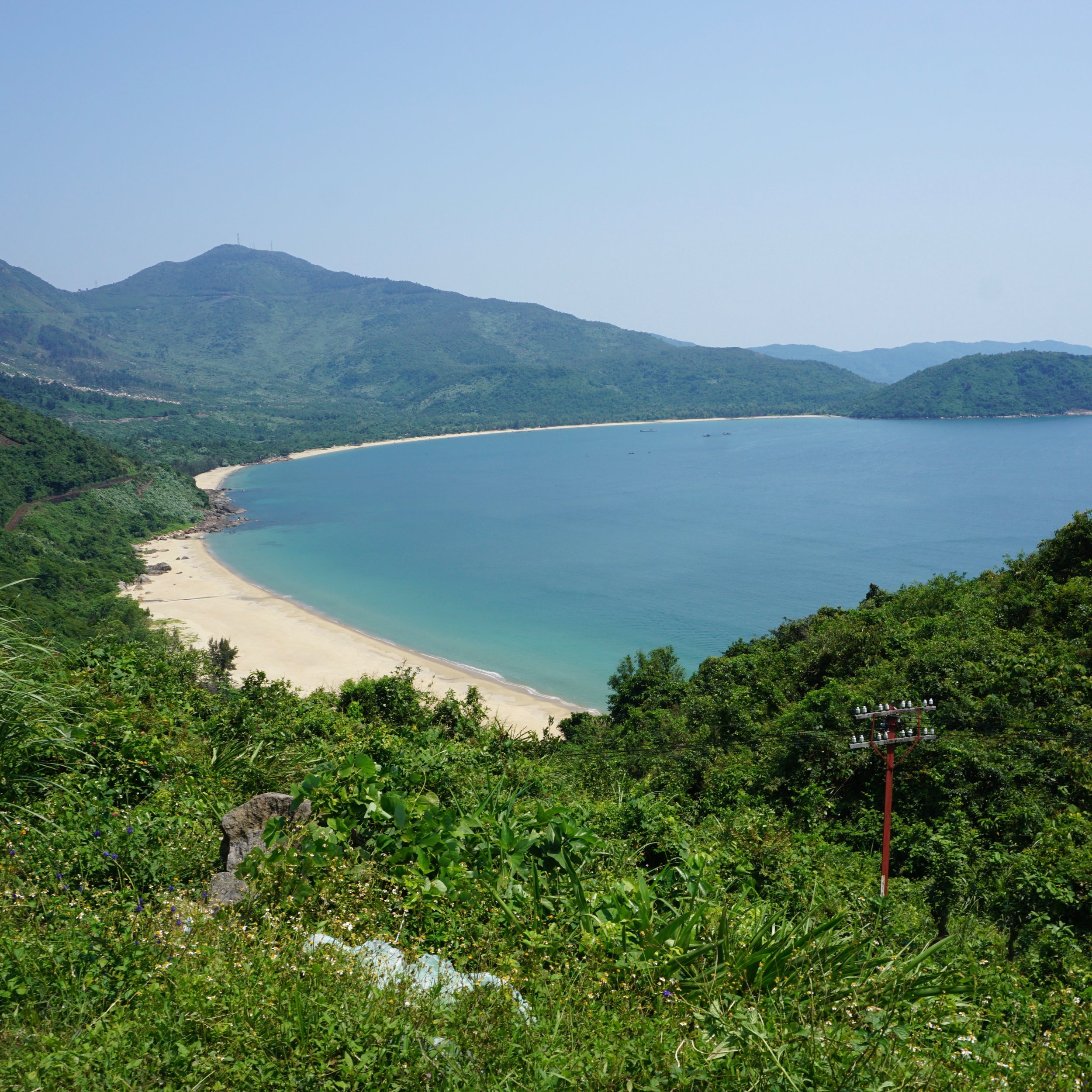
Experiences in Hai Van Pass
Riding up Hai Van Pass by Motorbike
Whether self-riding or being a pillion, the ride up and down the Hai Van Pass is a fantastic experience that is definitely worth it to do. That’s a real adventure in which visitors are always excited to see what is next and even want to enjoy one more time. Well-protected forests, breath-taking landscapes, old remains, winding roads that challenge the rider a bit and lots of photo opportunities, are rewards. All are outdoors and support freedom.
It’s fun to snake over 20 kilometers across an incredibly untouched nature, and feel how the weather changes in different elevations. There is not surprising to be in high temperatures in the foot, but over time, the degrees gradually decrease and increase again when going downhill. Dense mist doesn’t allow you to see far and by that, the explorers keep curious about things they will see in the front. Unpredictably, a cow or deer makes the ride slow down a bit at times. If traveling with a tour guide, he may share little-told stories and history, including the ones giving creepy feelings. Former traffic accidents claimed many lives.
Local people see the ride up to the top of Hai Van Pass is a joy on the weekend, and never forget stopping somewhere for a cup of coffee.
Hai Van Pass Train
If you have ever been in Hai Van Pass or will explore it soon, a train travel along the below coast is highly recommended. Since it was established by the French, the coaches, tracks and scenery along the railroad are nearly unchanged. From the window, a striking coastline with inaccessible cliffs, sandy beaches and lush vegetation, sometimes shows and sometimes hides (by tunnels). The train itself has an old-fashioned style and the smallest sizes in the world right now, but are what many travelers find. The “outdating” facilities give feelings that the passengers are back to a few decades or one century. Tickets are sold online or in central train stations in Da Nang or Hue. Browse our guide for this off-the-beaten-track transfer in centralvietnamguide.com/da-nang-to-hue-train.
Hai Van Pass Cycling
Featuring a scenic route with high gradients, Hai Van Pass is a dream ride to many cyclists, in and outside of Vietnam. Different from motorcycle rides, an expedition on the wheels occurs slower, eco-friendly and thanks to that, becomes the favourite to laid-back travelers. It takes one day to discover everything from Da Nang and Hoi An to Hue, and vice versa. Visit Hue another time? There are two options to select: repeating the pass ride and taking a transfer through the Hai Van tunnel. The first is more stunning, but the second saves time for the rider. Read complete travel guides to traveling with a bike in your city for further details, as following below:
- Hoi An Bike Tour
- Da Nang Bike Tour
- Hue Cycling Tour
Swim in Hai Van Pass Elephant Springs
Not too far from the foot of Hai Van Pass, Suoi Voi (or the Elephant Spring) is a good place to cool down. Its clear and unpolluted water flowing down from Bach Ma national park, and aside rocks. There are many huts available to put the bags, eat grilled chicken with chilli salt and drink cold beers. On the weekend, this attraction is busier. Parking, hiring the hut, foods and drinks, all charge a fee.

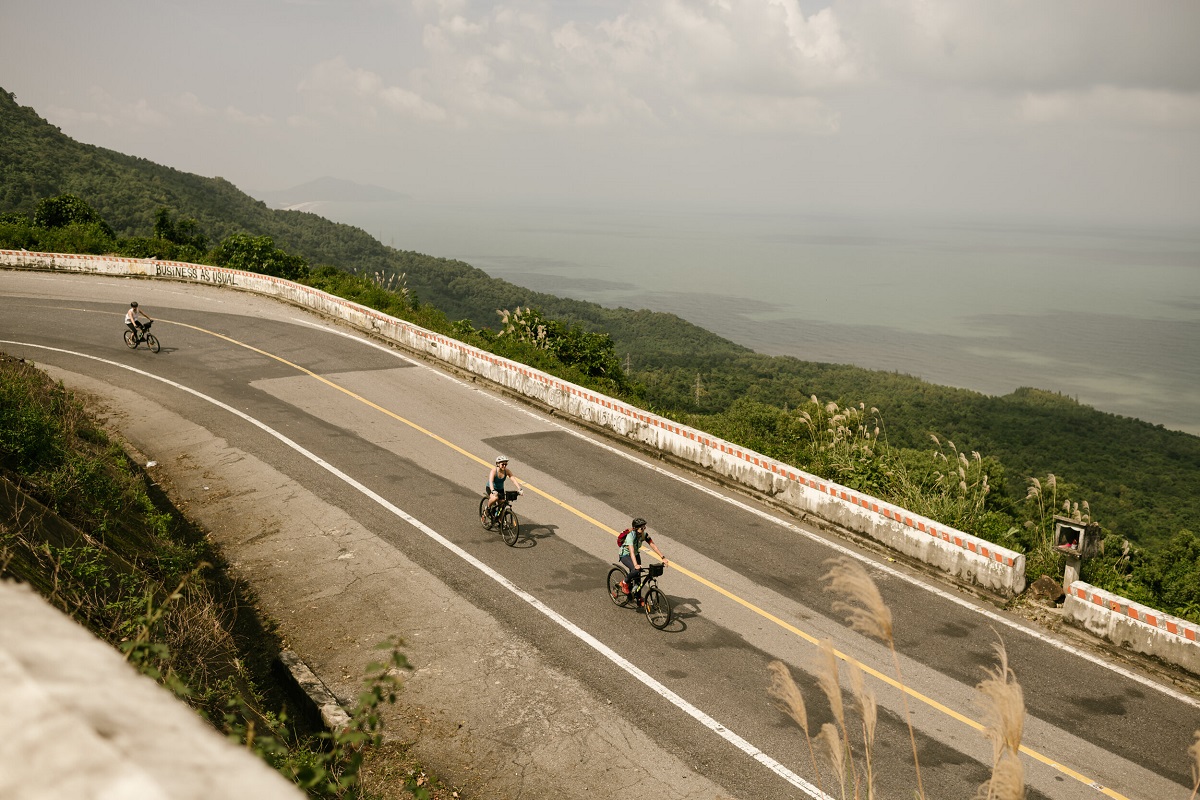
How to Get to Hai Van Pass
Get to Hai Van Pass by Motorbike
Motorbike is the top choice for both locals and tourists, to explore the Hai Van Pass. Ensure that you have a driving license before making up your mind, because the mountain pass is not really too easy for beginners. Traffic is still busy in many hours of the day, including trucks carrying petrol, animals and tourist buses. Experience is required, to keep yourself away from unexpected injuries. Being a pillion will be the perfect solution. You can hire a local driver or a travel friend who is confident in his/her riding skills. Looking for the Easy Rider, an independent or group of professional English-speaking riders. The operators specializing in bike tours provide many selections at varying prices.
Read also: Da Nang Bike Tour, Hoi An Motorbike Tour, Hue Motorbike Tour
Car and Tourist Bus
These are two next popular vehicles tourists choose to visit the Hai Van Pass. It’s more flexible and comfortable if traveling by a car, than in a tourist bus. Private car rentals are a lot to choose from any cities nearby, with a competitive price. Especially, if departing from Hue, should make full use of it to transfer to Da Nang or Hoi An. It takes nearly 2 hours to start the first turns in the pass and just a half from the City of bridges and City of lanterns. Booking an organized tour if needing a local guide who is knowledgeable, fluent in English and friendly.
Also it is a nice choice to move between three cities, the tourist bus cost is smaller, around 250,000 VND for an air-conditioning seat. The ride durates roughly 3 to 4 hours, and before paying, remembering to ask how the seat is: bunk bed in the sleeper bus or a seat on the couch. On the pass, it may stop at a pair of places to allow visitor’s sightseeing, including the summit. The Marble Mountains is another included attraction, but available in some providers only. Places to eat, take a break or go to the restroom are absolutely recommended by the driver and attendant.
Bicycle and Jeep
Son Tra and Hai Van mountains are two most idyllic places in Da Nang, for an adventure with a bike. To ensure having a fully-enjoyable ride, carefully check the vehicle that will travel with you over different elevations. Lots of water is needed in the dry months, but it’s necessary to see the forecast in advance, to avoid heavy rains or typhoons. No matter if you aim to get a self-guided or guided cruise, we recommend reading three comprehensive guides to the city you’re staying. There are about the Hoi An Bike Tour, Da Nang Bike Tour, and Hue Motorbike Tour.
Visitors can hire a jeep rental with and without a tourist guide to discover the Hai Van Pass. The price of the second option is definitely cheaper. Like trips with a bike, both half-day and full-day experiences are available if the hotel is in Da Nang or Hoi An. For Hue stayers, a day trip or transfer are more popular. Read our articles for Jeep Tour in Da Nang and Jeep Tour in Hoi An, to find out the best providers or packages for yourself.

Self-Riding the Hai Van Pass by Motorbike
Rentals and Directions
Motorbike rental in any cities of Central Vietnam is easy. Visitors just need to pay from 100,000 to 200,000 VND to hire one, per day and without fuel. The quickest way is coming down the reception and telling the requirements. Staff there may help. If staying over in Da Nang or Hoi An, it’s comfortable to get to the Hai Van Pass and return within a day. If being in Hue, the ride is long (around 200 km). Therefore, many travelers make full use of their transfer from the city to Da Nang and Hoi An to visit the pass. Besides allowing self-riding, some local operators can arrange a transportation of luggages to the arrival city, as a part of the rental. See the most reliable providers in our guide to Hoi An to Hue Motorbike Tour (and vice versa).
From Hoi An and Da Nang, the best route to get to Hai Van Pass is the coast road. No matter departing from where, Nguyen Tat Thanh Rd (bayfront) is better than others inside. From Hoi An, following Lac Long Quan Rd until the My Khe beach and then, selecting a boulevard to cross the favourite bridge. To the right, riverside Bach Dang Rd leads to the bayfront. Start from Hue? There are two routes: the National highway 1A and the coast road QL49B. The first is wider, moderner but the second is less busy. See detail of the routes on the map, stroll down to the section “Hai Van Pass Map and Route” below.
What to Bring?
Visitors should bring sun cream, sunglasses, water, cash, phone, camera and backup charger. In the wet season, more layers are necessary to keep warm throughout the ride and of course, a raincoat is never forgotten. If you have a GoPro, that’s great to record the fun journey.
Roadside Assistance
Keeping in mind to save the telephone number of the place where you hire the bike, is the first tip. Topping up the phone in advance, to ensure any calls can be made (without interruptions). In fact, reputable shops provide the quickest assistance because their mechanics are always ready to help. If you take the bike from a hotel, you may wait longer. Above all, the most important advice is checking carefully prior to riding to the pass.
On the rocks or barriers, some phone numbers of local mechanics are painted on. Call them if you can’t contact anyone for help. Asking for the price before accepting the assistance.
Eat and Drink
Coffee shops and eateries open in the daytime along the Hai Van Pass’s route, including near the ancient gates. Only traditional coffees are available, particularly three types: ca phe den (only coffee), ca phe sua (coffee with a little condensed milk) and bac siu (many condensed milk-little coffee). If needing to serve with ices, say ca phe den da and ca phe sua da to let the owners know. The price is local. The best shop is near the Turtle Rocks where visitors can stand on the top and admire a beautiful panoramic view.
If requiring better seating and atmosphere, Lang Co town in the northern side provides numerous choices. There are seaside or lagoon-edged restaurants or places to eat for Vietnamese only. Seafood venues include the list. The best view is provided from a place by the shore of the lagoon. Read our articles for Lang Co Beach and Lang Co Lagoon for more details.
Hai Van Pass Tour
Hai Van Pass Motorbike Tour
This is the best seller Hai Van Pass tour among all local adventure operators. Visitors can have three choices to select: self-riding (as a bike rental), self-riding but following a guide, and being a pillion. If you are an explorer, the first may be your choice, because you will do whatever you want and without rush. But the second selection allows me to meet a new friend who is knowledgeable and shares interesting things during the trip. The final is for those who can’t ride, have a little experience or just like to relax in the back. Price between these has not a big difference. Full-day experiences often include a lunch but you can call your favourite dishes and pay by yourself, if requested. For self riders, make sure that you know the map with routes and places at the end of this article, before hitting the road.
Read also: Hoi An Motorbike Tour, Da Nang Bike Tour, Hue Motorbike Tour
Hai Van Pass Jeep Tour
Traveling with a jeep to Hai Van Pass is more special than other transportations. During the ride, visitors can sit together with beloved family members or fellow friends, instead of being alone on a motorcycle. Unlike the cars and buses, the seatings are open air, allowing the passengers closest to the fresh nature and beautiful landscapes. Still being flexible, the jeep can stop anywhere, to take a photo or just stand to enjoy the beautiful world before the eyes. It’s possible to hire a tour (rental) with or without a local guide in some jeep-specialized organizers. Thanks to being close to Hoi An and Da Nang, a half-day expedition to the pass can be arranged. But from Hue, let’s be ready to spend a whole day if would like to return. Jeep transfers between three cities are available all year round to book.
Read also: Jeep Tour in Hoi An, Jeep Tour in Da Nang

Hai Van Pass Facts
#1: Hai Van Pass is the southern margin of North Vietnam biome and the northern margin of Southern Vietnam biome. Therefore, forests in it show a mix of two biomes, in both flora and fauna. Thanks to this special combination, Bach Ma national park is one of the richest wildlife areas in the country.
#2 Ownership of Hai Van Gate at the top of Hai Van Pass is conservative for a few decades. Both Hue and Da Nang cities say it belongs to it. This debate led to lack of conservation care in the remains until recently. Now, the gate has been reconstructed as a result of a “peace treaty”.
#3 Northern side of Hai Van Pass is famous for the highest rainfall in Vietnam, up to 8,000 milliliters per year. The largest river originating from it is the Perfume River.
Travel Guide to Lang Co Beach
Lang Co is north of Hai Van Pass, in Hue’s administrative boundaries. It’s a fishing town on a peninsula, a beach (to the East), and a lagoon (to the West). The name means “the stork village”. In fact, any trips to Hai Van Pass include these places and each provides different things. In the peninsula, visitors can find local eateries, fishing boats and markets to see, while by the lagoon or the sea, the scenery stands out. Water-edged seafood venues, both touristy and non-touristy can be found around. Read our travel guides to Lang Co Beach and Lang Co Lagoon to find out all the secrets.
Hai Van Pass on Google Maps
Related Posts
Non Nuoc Beach: The Famous Beach of Da Nang
Besides the Golden hands bridge – a global hit, Da Nang city also has beautiful beaches. If looking for somewhere great to stay and have a slow holiday, Non Nuoc
How to Get from Da Nang to My Son Sanctuary
Known as ‘the Angkor Wat of Vietnam’, My Son sanctuary boasts of its sophisticated temples dating back from 4th century. Sadly, in 14th century, it’s abandoned in the forests. Today,
Bach Ma National Park: Hiking, Trekking in Da Nang and Hoi An
Two best places for trekking and hiking in and near Da Nang are Son Tra mountain (peninsula) and Bach Ma national park. Which one is better is actually personal because these
Am Phu Cave (Hell Cave) – Things to Do in Da Nang
Although in the Marble mountains – the most visited attraction in Da Nang, travelers often miss Am Phu cave. One of reasons is that it’s mentioned much online and not
Asia Park and Sun Wheel in Da Nang (Sun World Da Nang Wonders)
Have you ever seen the wheel of Da Nang? That is the Sun Wheel. It’s a part of greater Asia Park – an amusement park with a heap of fun
How to Get to Golden Bridge from Da Nang
The Golden Bridge (aka the Golden Hands Bridge) in Da Nang is a must visit attraction in Vietnam today. Many foreign travelers come to the city, just because they love
Da Nang Food Specialties: What to Eat in Da Nang
Da Nang is known as a food capital of central Vietnam. This city boasts many yummy dishes, prepared by distinctive recipes and some of them are famous all over the
How to Visit Golden Bridge Vietnam
The Golden Hand Bridge of Ba Na hills today is a dream place to visit for many travelers. Since it opened in June 2018, millions of people have set their
Da Nang Shore Excursions: Guided Tours From Tien Sa Port
Da Nang Vietnam today is one of stopovers for many cruises that travel from continent to continent, from country to country. It owns an ideal seaport to moor and it
Han Market (Cho Han): Where to Shop in Da Nang?
In the heart of Da Nang, the Han market is a popular place for visitors to buy something to bring home due to the diversity of merchandise. Back to history,
Da Nang Cathedral (Da Nang Pink Church)
Da Nang became a French protectorate on 3rd October 1888, under the name “Tourane”. By the Han river, the colonists designed a grid of streets with public buildings, a city hall,
Things to Do in Ba Na Hills Besides Golden Bridge
According to local authorities, 50% of visitors coming to Da Nang and Hoi An visit the Ba Na hills. In other words, that is nearly 10 millions of people. This
Da Nang Half Day Tours
In addition to day trips, travelers have many options of half-day tours in Da Nang to choose from. Not to spend a full day at different places, maybe far from
Da Nang Private Car and Driver
Your next holiday destination is Da Nang? You prefer to travel by yourself? Hiring a private car is one of the best options for you to explore with freedom, flexibility
Da Nang and Hoi An Itinerary for Visitors Staying Overnight in Hoi An
Da Nang and Hoi An are twin cities in the heart of Central Vietnam. Both are popular tourist destinations for either domestic or international visitors, and share many similarities. Due
Da Nang Things to Do: Guide to What to Do in Da Nang Vietnam
Unquestionably, Da Nang deserves a holiday trip from all types of traveller. Firstly, due to the weather. It has a longer sunny time than the north but less hot than
Da Nang Best Things to Do and Reasons
Da Nang is the largest tourist center in Central Vietnam. It owns fascinating natural and cultural places that attract both Vietnamese and foreigners. In the busiest year, this city of
How to Get From Hoi An to Da Nang
Da Nang is the neighbouring city of Hoi An. It's the capital of Central Vietnam and has the most important (busiest) transport hubs of the region, such as airport, train
Hoi An or Da Nang: Which is Better for First Time Visitor?
Da Nang and Hoi An are located in Central Vietnam, with a distance of roughly 30 km. To the north, Da Nang is the capital city of the region, with
My Son Sanctuary Tour
My Son Sanctuary is a Unesco world heritage site, attracting 450,000 visitors in recent years. It’s the best remains left by the fallen Champa Kingdom which ruled a part of
Da Nang Best Area to Stay: Guide to Where to Stay in Da Nang
In the Central coast, Da Nang has an area of 1,285 km2 and population of 1,134 people, making it become Vietnam’s 4th largest city. It plays an important role in the
Da Nang Cave Tour: Best Underground Activities in Da Nang
Different from Hue and Hoi An, Da Nang has limestone caves and grottoes. All of them are within the Marble Mountains (Ngu Hanh Son), a complex of 5 amazing hills
Da Nang Best Time to Visit: Guide to Best Weather in Da Nang
Da Nang is titled “Asia’s leading festival and event destination” by the World Travel Awards or Vietnam’s greenest city by the WWF. Its reputation comes from amazing natural mountain-to-sea sceneries,
Da Nang Weather by Month: Guide to Monthly Weather in Da Nang
In Central Vietnam, Da Nang has a tropical monsoon climate with two distinct seasons that each starts later than the North 2 months. Because of being shielded by the spectacular
What to Do in Da Nang At Night
Between the sunset and midnight, there are many things to do in Da Nang that travelers should know before getting to bed. Thankfully, different styles of traveling, budget or ages
Lang Co Vietnam Travel Guide
Lang Co was a lovely backwater town nestled at the foot of spectacular Hai Van Pass for some decades. Not yet widely known because of the popularity of beaches in
What to Do in Da Nang for 3 Days
Da Nang is a lovely coastal city in the middle of 3 Unesco world heritages Hue, Hoi An and My Son Sanctuary. This most worth-living municipality owns a poetic river
My Khe Beach: A Complete Guide to Da Nang’s Best Beach
Da Nang is a lovely seaside city with many beaches, and the best is My Khe. Located on the eastern coastline, it’s between little-known beaches near the foot of Son
Da Nang Day Trips: Guide to Best Day Tours From Da Nang
Centre and outskirts of Da Nang have incredible attractions where travellers need to spend many hours to get to and fully explore. There are the Ba Na Hills and Golden
Museums in Da Nang
Da Nang has many museums where visitors can see and learn a lot. Generally, their exhibitions have different themes, varying in stages of the history, groups of people (communities) having
Linh Ung Pagoda: Trio of Da Nang’s Holiest Mountain Temples
Linh Ung means “wishes answered miraculously” in Sino-Vietnamese. And it’s first used in 1841 to name a pagoda in the Marble Mountains by Thanh Thai, the 10th king of the
Da Nang Night Market: A Thing To Do in Da Nang at Night
Different from day markets in Da Nang, night markets are held open-air and on streets where traffic is active during sunny hours. A visit there provides the chance to understand
Guide to Son Tra Mountain (Monkey Mountain) in Da Nang, Vietnam
From My Khe Beach or Han River promenades, tourists can see a part of the Son Tra Mountain. Although being near the city center, natural forests on its slopes have
Ba Na Hills Tour
Ba Na Hills is one of the best attractions in Da Nang, and the country. Its full name is the Ba Na-Suoi Mo Tourist Area, made from “Ba Na hill
Da Nang Cable Car
No surprise that now, when travelers make the plan to tour around Vietnam, there are many cable car rides recommended. Some are top things to do in its cities. The
How to Get from Da Nang Airport to Hoi An
Located in the city of the same name, Da Nang airport is the nearest airport to Hoi An. So, if travelers want to see an extremely-colorful Lantern festival or try
Da Nang to Hoi An: Best Da Nang Airport Transfer and More
If traveling to Hoi An by air, train and cruise ship, visitors will come to Da Nang first and then have a transfer. The largest city of Central Vietnam holds
Hai Van Pass Da Nang: Map, Route, Weather, History, Tour
Truong Son or Annamite Range is the most dramatic mountain ridge in Vietnam. When it juts out into the sea, spectacular Hai Van Pass is formed. This amazing sculpture of
Da Nang Attractions Guide: What to See in Da Nang Vietnam?
Da Nang is the capital city of the Central region, and one of the most attractive destinations to tourists in Vietnam. It’s established by French colonists and called by them
Guide to Lady Buddha (Goddess of Mercy) in Monkey Mountain, Da Nang
From the East coast, visitors can see an enormous white statue with the mountain backdrop, that is the Lady Buddha Da Nang. Located in the ground of Linh Ung Pagoda,
My Son Sanctuary Travel Guide
My Son Sanctuary is a complex of Hindu temples and a Unesco world heritage site from 1999. It’s 40 km away from Hoi An and 70 km to the southwest
Da Nang Museum of Cham Sculpture
Da Nang Museum of Cham Sculpture is a highlight of the Han river waterfront. It’s established by French archaeologists to preserve intricate works of art of Champa kingdom, which ruled
Dragon Bridge Da Nang: The Fire-Breathing Da Nang Bridge
Praised to be the world's 30 most unique bridges recently, Dragon Bridge became the new icon for a Han river bridge in Da Nang. Spanning from the 100-years-old Cham Museum,
Ba Na Hills Travel Guide: A First Timer’s Complete Guide
50% of visitors to Da Nang plan to visit Ba Na Hills in their itinerary. It’s larger for first timers who may know about its inspirational Golden Bridge, world-record cable
Golden Bridge Da Nang: A Guide to The Iconic Da Nang Bridge
Recently-built but at the present time, the Golden Bridge Da Nang is one of the awaited attractions in Vietnam. On a slope of high foggy mountain, this delicate bridge and
Da Nang Bridge: A Guide to Famous Bridges in Da Nang
Da Nang has many bridges, and some of them are famous nationally and internationally. Before the recently-built Golden Bridge which made a boom in social media, people only knew bridges
Ba Na Hills Cable Car: World Record, Cost, Reschedule, Map
Cable car is one of the first ideas travelers think about Ba Na Hills, a Da Nang’s top attraction. It helps to shorten the time to get to the hills
Da Nang Mountain Temple: Marble Mountain’s Pagodas, More
Da Nang has many mountain temples where handmade architecture, natural sceneries and religious values are combined perfectly. So, travelers will see, enjoy and learn a lot about different things just
Da Nang Caves: Underground World of the Marble Mountains
One of the priceless gifts Mother nature gives to Da Nang is an array of caves and caverns. Almost all are located in the Marble Mountains, a complex of
The Marble Mountains: Guide to Da Nang’s Iconic Mountain
Had been an offshore group of islands, geological activities shifted the Marble Mountains to the land some thousands of years before. Today, its marble hills rise suddenly up to over 100

















































